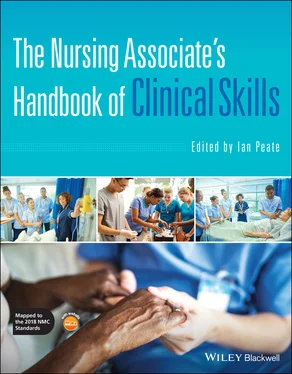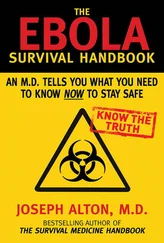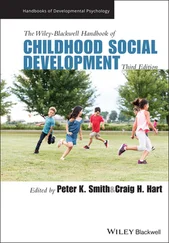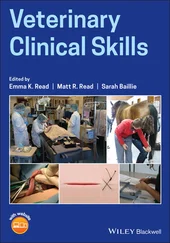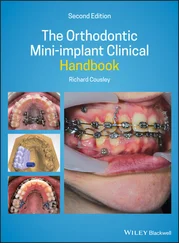The Nursing Associate's Handbook of Clinical Skills
Здесь есть возможность читать онлайн «The Nursing Associate's Handbook of Clinical Skills» — ознакомительный отрывок электронной книги совершенно бесплатно, а после прочтения отрывка купить полную версию. В некоторых случаях можно слушать аудио, скачать через торрент в формате fb2 и присутствует краткое содержание. Жанр: unrecognised, на английском языке. Описание произведения, (предисловие) а так же отзывы посетителей доступны на портале библиотеки ЛибКат.
- Название:The Nursing Associate's Handbook of Clinical Skills
- Автор:
- Жанр:
- Год:неизвестен
- ISBN:нет данных
- Рейтинг книги:4 / 5. Голосов: 1
-
Избранное:Добавить в избранное
- Отзывы:
-
Ваша оценка:
- 80
- 1
- 2
- 3
- 4
- 5
The Nursing Associate's Handbook of Clinical Skills: краткое содержание, описание и аннотация
Предлагаем к чтению аннотацию, описание, краткое содержание или предисловие (зависит от того, что написал сам автор книги «The Nursing Associate's Handbook of Clinical Skills»). Если вы не нашли необходимую информацию о книге — напишите в комментариях, мы постараемся отыскать её.
The Nursing Associate’s Handbook of Clinical Skills
The Nursing Associate’s Handbook of Clinical Skills
The Nursing Associate's Handbook of Clinical Skills — читать онлайн ознакомительный отрывок
Ниже представлен текст книги, разбитый по страницам. Система сохранения места последней прочитанной страницы, позволяет с удобством читать онлайн бесплатно книгу «The Nursing Associate's Handbook of Clinical Skills», без необходимости каждый раз заново искать на чём Вы остановились. Поставьте закладку, и сможете в любой момент перейти на страницу, на которой закончили чтение.
Интервал:
Закладка:
Conclusion
At the point of registration, the nursing associate will to have demonstrate that have the knowledge, skills and behaviours to communicate effectively with people across the lifespan in a variety of healthcare and social care settings.
Effective communication and relationship management skills have to be learnt and honed in order to ensure that the patient is at the centre of all that is done. To be able to communicate effectively, with sensitivity and compassion, and to manage relationships with people is key to the provision of high‐quality, person‐centred care.
When those people being care for and offered support to have special communication needs or a disability, it is important that the nursing associate make reasonable adjustments. This will mean that they will be able to provide and share information in such a way that promotes good health and health outcomes and enables equal access to the highest quality of care.
References
1 Aggarwal, V.B. and Gupta, V.S. (2001) Handbook of journalism and mass communication. New Delhi: Concept Publishing Company.
2 Alzheimer’s Society. (2016) Communicating, Factsheet 500LP, London: Alzheimer’s Society.
3 Alzheimer’s Society. (2017) What is dementia, Factsheet 400LP. [online] Available: https://www.alzheimers.org.uk/sites/default/files/migrate/downloads/what_is_dementia.pdf. Accessed 6 September 2020.
4 Alzheimer’s Research UK. (2019) 11 things you need to know about dementia. [online] Available: https://www.alzheimersresearchuk.org/about‐dementia/facts‐stats/11‐things‐you‐need‐to‐know‐about‐dementia/. Accessed 6 September 2020.
5 Boggs, K. (2016) Communicating with children, in Arnold, E. & Boggs, K (eds.) Interpersonal relationships: professional communication skills for nurses (7th edn),. Philadelphia: Elsevier, 345–363. ISBN: 978‐0‐323‐24281‐3
6 Edwards, S. and Coyne, I. (2019) A nurse’s survival guide to children’s nursing (updated), London: Elsevier.
7 Fitzsimons, B. (2018) End‐of‐life care; when there is only one chance to get it right. [online] Available: https://www.rcplondon.ac.uk/news/end‐life‐care‐when‐there‐only‐one‐chance‐get‐it‐right. Accessed 6 September 2020.
8 Grainger, C. (2018) Effective communication skills, in Peate, I. (ed.) Learning to care; the nursing associate, London: Elsevier, 83–95.
9 Haddad, A., Doherty, R. and Purtilo, R. (2019) Health professional and patient interaction, Missouri: Elsevier.
10 Lasswell, H. (1948) The structure and function of communication in society, in Bryson, L. (ed.) The communication of ideas, New York, NY: Institute for Religious and Social Studies, 117.
11 Leifer, G. (2019) Introduction to maternity and pediatric nursing (8th edn), London: Elsevier.
12 Mansell, J. (2010) How to guide 3; communication for people with profound and multiple learning disabilities, London: Mencap.
13 MENCAP. (n.d.) Communicating with people with learning disability. [online] Available: https://www.mencap.org.uk/learning‐disability‐explained/communicating‐people‐learning‐disability. Accessed 6 September 2020.
14 Mental Health Foundation. (2019) Learning disability statistics. [online] Available: https://www.mentalhealth.org.uk/learning‐disabilities/help‐information/learning‐disability‐statistics. Accessed 6 September 2020.
15 National Institute for Health and Care Excellence. (2019) NICEimpact mental health. [online] Available: https://www.nice.org.uk/about/what‐we‐do/into‐practice/measuring‐the‐uptake‐of‐nice‐guidance/impact‐of‐guidance. Accessed 6 September 2020.
16 National Institute for Health and Care Excellence. (2014) Delirium in adults; Quality standard [QS63]. [online] Available: https://www.nice.org.uk/guidance/qs63. Accessed 6 September 2020.
17 Nelson, J. (2012) Introduction to counselling skills: text and activities (4th edn), London: Sage.
18 Nursing and Midwifery Council. (2018a) Standards of proficiencies for nursing associates. [online] Available: https://www.nmc.org.uk/globalassets/sitedocuments/education‐standards/nursing‐associates‐proficiency‐standards.pdf. Accessed 3 October 2019.
19 Nursing and Midwifery Council. (2018b) The code ‐ professional standards of practice and behaviour for nurses, midwives and nursing associates. [online] Available: https://www.nmc.org.uk/globalassets/sitedocuments/nmc‐publications/nmc‐code.pdf. Accessed 3 October 2019.
20 Parliamentary and Health Service Ombudsman. (2019) Complaints about the NHS in England: quarter 2 2018–19. [online] Available: https://www.ombudsman.org.uk/sites/default/files/2018‐12/Complaints_about_the_NHS_in_England_Quarter_2_2018‐19_Final_Accessible.pdf. Accessed 6 September 2020.
21 Parnell, T.A. (2015) Health literacy in nursing: providing person centred care, New York, NY: Springer Publishing Company.
22 Public Health England. (2018) Severe mental illness (SMI) and physical health inequalities: briefing. [online] Available: https://www.gov.uk/government/publications/severe‐mental‐illness‐smi‐physical‐health‐inequalities/severe‐mental‐illness‐and‐physical‐health‐inequalities‐briefing. Accessed 6 September 2020.
23 Raphael‐Grimm, T. (2015) Art of communication in nursing and health care: an interdisciplinary approach, New York, NY: Springer Publishing Company.
24 Rautakoski, P. (2011) Training total communication, Aphasiology, 25(3): 344–365. doi: 10.1080/02687038.2010.530671.
25 Richards, A. and Edwards, S. (2019) A nurses survival guide to the ward (3rd edn), London: Elsevier.
26 Richardson, B. (2017) Communication, in Moore, T. & Cunningham, S. (eds.) Clinical skills for nursing practice, Abingdon: Routledge, 23–46.
27 Roberts, J.F., Fenton, G. and Barnard, M.C. (2015) Developing effective therapeutic relationships with children, young people and their families, Nursing children and Young People, 27(4): 30–35. doi: 10.7748/ncyp.27.4.30.e566.
28 Royal College of Nursing. (2016) Why communication is important. [online] Available: https://rcni.com/hosted‐content/rcn/first‐steps/why‐communication‐important. Accessed 6 September 2020.
29 SCIE. (2015) Dementia. [online] Available: https://www.scie.org.uk/dementia/about/. Accessed 6 September 2020.
30 Sense. (2019) Total communication. Retrieved 9 November 2019. [online], Available: https://www.sense.org.uk/get‐support/information‐and‐advice/communication/total‐communication/. Accessed 9 November 2019.
31 Templeman, J. (2019) Communicating, in Holland, K. & Jenkins, J. (eds.) Applying the roper Logan Tierney model in practice (3rd edn), London: Elsevier, 105–142.
32 Thomsen, O.N. (2010) From talking heads to communicating bodies: cybersemiotics and total communication, Entropy, 12(3): 390–419. doi: 10.3390/e12030390.
33 Woodrow, P. (2019) Intensive care nursing; a framework for practice (4th edn), London: Routledge.
3 Interpersonal Skills and Therapeutic Relationship Skills
Joanna Regan1 and Karen Wild2
1Leeds Teaching Hospitals Trust, UK
2Nurse, UK
Chapter Aim
This chapter aims to provide the reader with an insight into the special nature of interpersonal and therapeutic relationship skills in patient–nursing associate interactions.
Learning Outcomes
By the end of this chapter, the reader will be able to:
Identify interpersonal and therapeutic relationship skills
Understand the skills required to enable a therapeutic relationship
Discuss the importance of the ‘6Cs’ that underpin the (National Health Service) NHS’s professional commitment to always deliver excellent care
Читать дальшеИнтервал:
Закладка:
Похожие книги на «The Nursing Associate's Handbook of Clinical Skills»
Представляем Вашему вниманию похожие книги на «The Nursing Associate's Handbook of Clinical Skills» списком для выбора. Мы отобрали схожую по названию и смыслу литературу в надежде предоставить читателям больше вариантов отыскать новые, интересные, ещё непрочитанные произведения.
Обсуждение, отзывы о книге «The Nursing Associate's Handbook of Clinical Skills» и просто собственные мнения читателей. Оставьте ваши комментарии, напишите, что Вы думаете о произведении, его смысле или главных героях. Укажите что конкретно понравилось, а что нет, и почему Вы так считаете.
